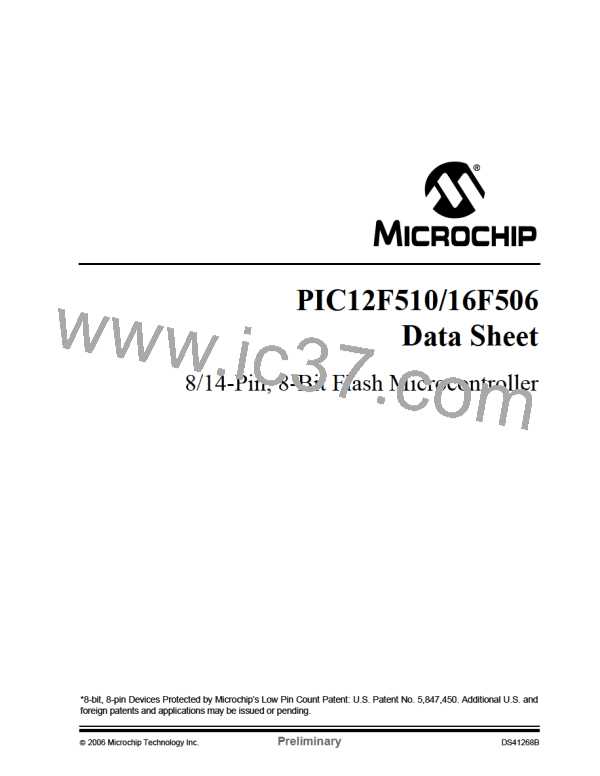PIC12F510/16F506
EXAMPLE 4-1:
HOW TO CLEAR RAM
USING INDIRECT
ADDRESSING
4.8
Indirect Data Addressing: INDF
and FSR Registers
The INDF register is not a physical register. Addressing
INDF actually addresses the register whose address is
contained in the FSR register (FSR is a pointer). This is
indirect addressing.
MOVLW
MOVWF
0x10
;initialize pointer
;to RAM
FSR
NEXT
CLRF
INCF
BTFSC
GOTO
INDF
FSR,F
FSR,4
NEXT
;clear INDF register
;inc pointer
;all done?
4.8.1
INDIRECT ADDRESSING EXAMPLE
;NO, clear next
CONTINUE
• Register file 07 contains the value 10h
• Register file 08 contains the value 0Ah
• Load the value 07 into the FSR register
:
:
;YES, continue
• A read of the INDF register will return the value
of 10h
The FSR is a 5-bit wide register. It is used in conjunc-
tion with the INDF register to indirectly address the data
memory area.
• Increment the value of the FSR register by one
(FSR = 08)
The FSR<4:0> bits are used to select data memory
addresses 00h to 1Fh.
• A read of the INDR register now will return the
value of 0Ah.
PIC16F506 – Uses FSR<6:5>. Selects from Bank 0 to
Bank 3. FSR<7> is unimplemented, read as ‘1’.
Reading INDF itself indirectly (FSR = 0) will produce
00h. Writing to the INDF register indirectly results in a
no operation (although Status bits may be affected).
A simple program to clear RAM locations 10h-1Fh
using indirect addressing is shown in Example 4-1.
PIC12F510 – Uses FSR<5>. Selects from Bank 0 to
Bank 1. FSR<7:6> are unimplemented, read as ‘11’.
FIGURE 4-5:
DIRECT/INDIRECT ADDRESSING (PIC12F510)
Direct Addressing
(opcode)
Indirect Addressing
(FSR)
(FSR)
4
3
2
1
0
5
3
2
1
0
6
4
5
6
bank select
bank
select
location select
location select
00
01
00h
Addresses map back to
addresses in Bank 0.
Data
Memory
0Fh
10h
(1)
1Fh
3Fh
Bank 1
Bank 0
Note 1: For register map detail, see Figure 4-2.
DS41268B-page 24
Preliminary
© 2006 Microchip Technology Inc.

 ETC [ ETC ]
ETC [ ETC ]